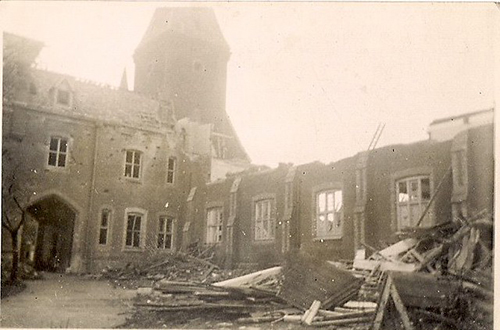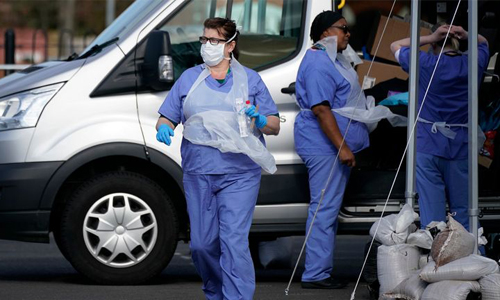
Professor Barry Doyle
Heath Historian
...recalls the emergency hospitals built for WWII and asks whether the lessons were learnt as the current government embark on similar policies with the opening of the Florence Nightingale Emergency Field Hospital in East London to combat the Covid-19
“The first of the government’s emergency hospitals has opened in London’s Excel Centre. More field hospitals are planned amid significant scaling back of non-Covid-19 hospital admissions. These are major changes to the way our hospitals operate with potentially lasting impact. So, what can we learn from similar emergency hospital policy during the Second World War?
With the opening of the Florence Nightingale Emergency Field Hospital in East London, the announcement of many more facilities in the pipeline, non-essential hospital treatments cancelled and deals done to access private beds, Covid-19 is transforming the NHS. But these policies are not new. Many were pursued on a larger scale during the Second World War under the Emergency Hospital Service (EHS) developed in the years running up to war. The EHS included plans to evacuate large numbers of patients, create thousands of temporary beds, reallocate private provision and make use of existing and new convalescent accommodation.
Why was such extensive intervention deemed necessary? Underpinning the policy was the fear of the bomber. Based on the experience of the destruction of Guernica during the Spanish Civil War, policy makers anticipated up to 1.2 million casualties in the first 60 days of a bombing campaign against British cities. Although Britain was well served with hospital accommodation – there were around 500,000 beds – these were spread across many different types of institution and two separate providers – the ‘voluntary’ acute hospitals and the local authority establishments caring for chronic, infectious and mental health patients.
The Pros and Cons of the EHS
The EHS does offer some potential insight into how the current policies will play out – also of the problems that health officials may encounter.
Cons
The policy rested on an initial phase in which C.140,000 patients were removed from institutions. These were mainly vulnerable: the chronic sick in old workhouse infirmaries, including cancer patients; the elderly and infirm; children with infectious diseases; long-term tuberculosis patients; and the mentally ill. These were mostly long-stay patients in local authority institutions, but many acute beds were also vacated in London. The government agreed to compensate for beds in acute hospitals as these were charitable not state controlled.
But casualties were not as severe as expected:
1. Bombing only began in summer 1940, nine months after the EHS started;
2. The military campaign also didn’t start until summer 1940 and was over fairly quickly;
3. Bombing casualty numbers, though severe, were much lower than expected and only occurred for a relatively short period;
4. Bombing casualties were not evenly spread across the country. As is well known, they were concentrated in London and certain industrial cities. Most places only experienced a few raids.
As a result, many EHS beds remained empty for long periods of time leading to growing waiting lists as ‘normal’ patients went untreated. Acute hospitals were accused of leaving beds empty deliberately to get state grants. Vulnerable patients remained in the community. Yet displaced groups – refugees, evacuees, war workers and sick soldiers – couldn’t get treatment as they were not part of the scheme for war wounded.
Pros
Some services were effectively redistributed – like those in Leeds – and probably worked better as a result. Spare capacity was available when the blitz came and also in 1944-5. 80,000 new beds were created in temporary hospital buildings, some on new sites. Resources in some institutions significantly improved, for example isolation hospitals like Seacroft, in Leeds, received operating theatres, X-Ray equipment and pathology laboratories. Much of this temporary accommodation was kept after 1945 and provided the basis for the extra capacity the new NHS needed in its first 15 years when capital projects were restricted.
Private beds in acute hospitals entered the system – indeed they probably constituted the largest part of acute hospital beds appropriated. The use of private beds reduced the impact on acute hospitals and secured income for hospitals that they may have been strapped for cash if demand for private treatment had dried up. It was quickly agreed that hospitals would be fully compensated for the loss of their private beds – though it did take some years for the grants to feed through.
Finally, convalescent beds took a lot of the pressure off acute services. In 1939, there were around 50,000 convalescent beds in Britain. Although a number, especially in seaside towns, closed during the war, their numbers were enhanced by further donations during war with many staffed by volunteers from organisations like The Red Cross and St John’s Ambulance.
Lessons
The NHS needs to be wary of squeezing existing capacity too hard and especially of postponing too many non-Covid-19 procedures. There have already been complaints, especially from cancer patients, that routine treatment has been cancelled indefinitely. If demand for existing hospital beds is less than expected, or it is patchy, this could cause medium term harm to the NHS – as it did to the acute charitable hospital system during and after the Second World War.
Temporary accommodation may not look as good as the conventional hospital, but it is a more sustainable response to this crisis. The temporary facilities could allow existing hospitals to carry on with more of their routine work and avoid the possibility of under-utilised capacity causing public anger. Unlike in 1945, however, these won’t need to be kept on after the crisis so there will be no ongoing cost.
Make use of the private sector. Paying for it is not a problem – it was paid for during the Second World War and reflects the fact that costs will be incurred by the owners of facilities. Overall, it is better to divert private beds – even at a cost – than to divert mainstream NHS hospitals and their staff.
Finally, we need to make more of the potential for a revival of the convalescent home. The NHS should be looking to free up capacity by moving recovering patients to non-acute facilities staffed by groups like The Red Cross and St John’s Ambulance volunteers. So, seek the loan of large properties – especially if they have been closed because of the crisis. And make use of those suitably-qualified volunteers. This approach has the scope to truly emulate the war time experience yet so far it seems to have attracted little attention.”
*I am very grateful to Dr Eli Anders for providing great information on convalescent homes during the war.
Politics
Browse all our blogs related to Politics.
Health
Browse all our blogs related to Health.


